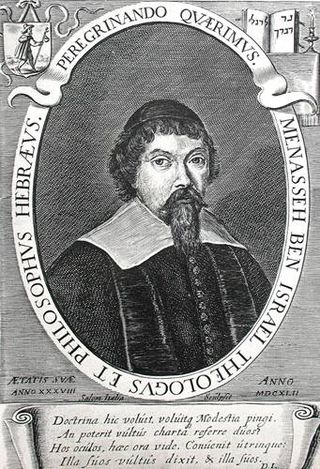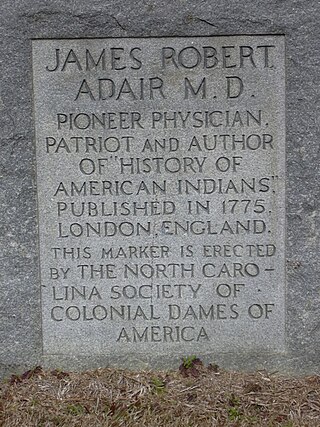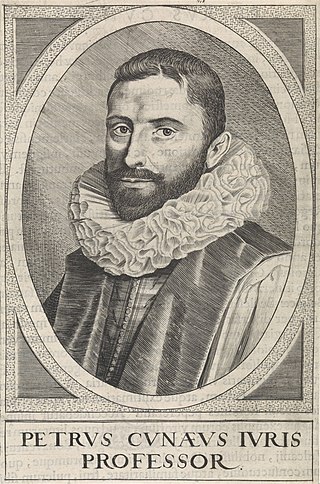Related Research Articles

Manoel Dias Soeiro, better known by his Hebrew name Menasseh ben Israel, also known as Menasheh ben Yossef ben Yisrael, also known with the Hebrew acronym, MB"Y or MBI, was a Portuguese rabbi, kabbalist, writer, diplomat, printer, publisher, and founder of the first Hebrew printing press in Amsterdam in 1626.
The History of Marranos in England consists of the Marranos' contribution and achievement in England.
The resettlement of the Jews in England was an informal arrangement during the Commonwealth of England in the mid-1650s, which allowed Jews to practise their faith openly. It forms a prominent part of the history of the Jews in England. It happened directly after two events. Firstly a prominent rabbi Menasseh ben Israel came to the country from the Netherlands to make the case for Jewish resettlement, and secondly a Spanish New Christian merchant Antonio Robles requested that he be classified as a Jew rather than Spaniard during the war between England and Spain.

The Bnei Menashe is a community of people from various Tibeto-Burmese ethnic groups from the border of India and Burma who claim descent from one of the Lost Tribes of Israel, with some of them having adopted Judaism. The community has around 10,000 members.
The Lost Chapter of the Acts of the Apostles, also known as the Sonnini Manuscript, is a short text purporting to be the translation of a manuscript containing the 29th chapter of the Acts of the Apostles, detailing Paul the Apostle's journey to Britannia, where he preached to a tribe of Israelites on "Mount Lud", later the site of St Paul's Cathedral, and met with Druids, who proved to him that they were descended from Jews. Thereafter, Paul preached in Gaul and Belgium, and then to Switzerland (Helvetia), where a miraculous earthquake occurred at the site of Pontius Pilate's supposed suicide.

James Adair (c.1709–1783) was a native of County Antrim, Ireland, who went to North America and became a trader with the Native Americans of the Southeastern Woodlands.

The ten lost tribes were the ten of the Twelve Tribes of Israel that were said to have been exiled from the Kingdom of Israel after its conquest by the Neo-Assyrian Empire c. 722 BCE. These are the tribes of Reuben, Simeon, Dan, Naphtali, Gad, Asher, Issachar, Zebulun, Manasseh, and Ephraim; all but Judah and Benjamin. The Jewish historian Josephus wrote that "there are but two tribes in Asia and Europe subject to the Romans, while the ten tribes are beyond Euphrates till now, and are an immense multitude, and not to be estimated by numbers".
John Dury was a Scottish Calvinist minister and an intellectual of the English Civil War period. He made efforts to re-unite the Calvinist and Lutheran wings of Protestantism, hoping to succeed when he moved to Kassel in 1661, but he did not accomplish this. He was also a preacher, pamphleteer, and writer.

Henry Jessey or Jacie was one of many English Dissenters. He was a founding member of the Puritan religious sect, the Jacobites. Jessey was considered a Hebrew and a rabbinical scholar. His active philosemitism has led him to be described as "among Israel's greatest seventeenth-century benefactors."
Nathaniel Holmes or Homes (1599–1678) was an English Independent theologian and preacher. He has been described as a “Puritan writer of great ability".
John Sadler was an English lawyer, academic, Member of Parliament, Town Clerk of London, Hebraist, Neoplatonist and millenarian thinker, private secretary to Oliver Cromwell, and member of the Parliamentarian Council of State. He was Master of Magdalene College, Cambridge from 1650 to 1660.

Petrus Serrarius was a millenarian theologian, writer, and also a wealthy merchant, who established himself in Amsterdam in 1630, and was active there until his death. He was born "into a well-to-do Walloon merchant family by name of Serrurier in London." He has been called "the dean of the dissident Millenarian theologians in Amsterdam".
Theaurau John Tany was an English preacher and religious visionary.

There are several explanations as to the origin of the Book of Mormon. Adherents to the Latter Day Saint movement view the book as a work of divinely inspired scripture. Secular theories of authorship propose that it is solely the work of man.
Antonio de Montezinos, also known as Aharon Levi, or Aharon HaLevi was a Portuguese traveler and a Marrano Sephardic Jew who in 1644 persuaded Menasseh Ben Israel, a rabbi of Amsterdam, that he had found one of the Ten Lost Tribes of Israel living in the jungles of the "Quito Province" of Ecuador. This supposed discovery gave a new impulse to Menasseh's Messianic hopes. Menasseh wrote a book about this narrative, The Hope of Israel. In it Menasseh argued, and tried to give learned support to the theory that the native inhabitants of America at the time of the European discovery were actually descendants of the [lost] Ten Tribes of Israel. The book was originally published in Latin and Spanish in 1650, but its publication in English in 1652 in London caused great controversy and polemics in England.

Petrus Cunaeus was the pen name of the Dutch Christian scholar Peter van der Kun. His book The Hebrew Republic is considered "the most powerful statement of republican theory in the early years of the Dutch Republic."
Abraham Pereyra was a wealthy and prominent Portuguese Jewish merchant, who lived in Amsterdam from circa 1644 to his death in 1699.
Hamon L'Estrange (1605–1660) was an English writer on history, theology and liturgy, of Calvinist views, loyal both to Charles I and the Church of England. Along with Edward Stephens, he contributed to the seventeenth-century revival of interest in ancient liturgies; with John Cosin and Anthony Sparrow he began the genre of commentary on the Book of Common Prayer. He has been confused at times with his father, son and grandson of the same name.
African Americans in Israel number at least 25,000, comprise several separate groups, including the groups of African American Jews who have immigrated from the United States to Israel making aliyah, non-Jewish African Americans who have immigrated to Israel for personal or business reasons, pro-athletes who formerly played in the major leagues in the United States before playing in Israel on local basketball and other sports teams, as well as foreign students studying in Israeli universities, businessmen, merchants, and guest workers, along with Israeli citizens of African American ancestry. African Americans have served in the Israel Defence Force, and have largely been accepted and into Israeli society, and have represented Israel in numerous international forums such as the Olympic Games, and the Eurovision Song Contest. African American-Israelis have had a major cultural impact in Israel, particular in the arts and culture, music and sports. In addition, there as a large community of Black Hebrew Israelites numbering at least 5,000 people, who originally immigrated to Israel from Chicago in the 1960s, and live mostly in the southern Israeli town of Dimona.
Jewish Indian theory was the erroneous idea that some or all of the lost tribes of Israel had travelled to the Americas and that all or some of the indigenous peoples of the Americas are of Israelite descent or were influenced by still-lost Jewish populations. The theory was popular in the late seventeenth century, and had a lasting legacy through its influence on Mormon belief.
References
- ↑ See, e.g., Adam Thoroughgood [Thorowgood], from a prominent family in King's Lynn, Norfolk, England. In the History of Norfolk annals he is described as "rector of Great Cressingham [Chapel]" - https://en.wikisource.org/wiki/History_of_Norfolk/Volume_6
- ↑ Tudor Parfitt, The Lost Tribes of Israel: The History of a Myth, London, 2003.
- ↑ Thorowgood, Thomas (1669). Ievves in America, or, Probabilities that the Americans are of that race. With the removall of some contrary reasonings, and earnest desires for effectuall endeavours to make them Christian. / Proposed by Tho: Thorovvgood, B.D. one of the Assembly of Divines (Digitized by University of Michigan). London.
- ↑ Peter Toon (ed.),Puritans, The Millenium and the Future of Israel: Puritan Eschatology, 1600-1660, Cambridge, 1970, pp. 117-118; Henry Méchoulan, and Gérard Nahon (eds.), Menasseh ben Israel: The Hope of Israel; The English translation by Moses Wall, 1652, introduction and notes by the eds., New York, 1987.
- ↑ Richard H. Popkin, "The Rise and Fall of the Jewish Indian Theory", in Yosef Kaplan et al (eds.), Menasseh Ben Israel and His World, Leiden, 1989, pp. 240-243; See also Lynn Glaser, Indians or Jews? An introduction to a reprint of Manasseh ben Israel's ‘The Hope of Israel’, Gilroy, California, Roy V. Boswell, 1973.
- ↑ More on this and on Eliot's possible own sources for the theory in Toon, op. cit., p. 118, and Glaser, op. cit., pp. 33-43.
- ↑ Richard H.Popkin, "Rabbi Nathan Shapira's Visit to Amsterdam in 1657", in J. Michman, and T. Levie (eds.), Dutch Jewish History, vol. 1, Jerusalem, 1984, p. 188; Glaser, op. cit., pp. 41-42. This second edition of 1660 is the one that contains the additional introduction called The Learned Conjectures of Rev. John Eliot touching the Americans.
- ↑ "An Epistolicall Discourse Of Mr. IOHN DƲRY, TO Mr. THOROWGOOD. Concerning his conjecture that the Americans are descended from the Israelites. With the History of a Portugall Iew, Antonie Monterinos, attested by Manasseh Ben Israel, to the same effect." https://quod.lib.umich.edu/e/eebo/A94301.0001.001/1:5?rgn=div1;view=fulltext
- ↑ "The Relation of Master ANTONIE MONTERINOS, translated out of the French Copie sent by MANASEH BEN ISRAEL." https://quod.lib.umich.edu/e/eebo/A94301.0001.001/1:9.1?rgn=div2;view=fulltext
- ↑ Méchoulan and Nahon (eds.), op. cit., pp. 66-68; Glaser, op. cit., pp. 33-43.
- ↑ The Wikisource entry in the linked article clarifies: "Sir Hamon was author of a work (often erroneously attributed to his son) entitled 'Americans no Jews, or improbabilities that the Americans are of that Race,' London, 1651 (October 1651)."; see Toon, op. cit., p. 117, and Glaser, op. cit., pp. 40-43.